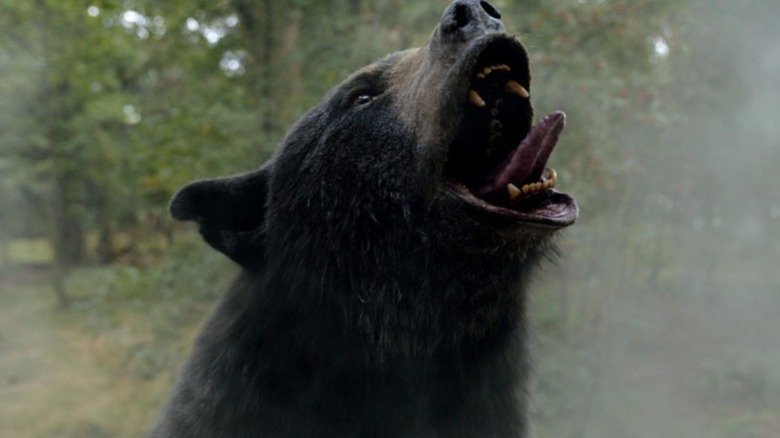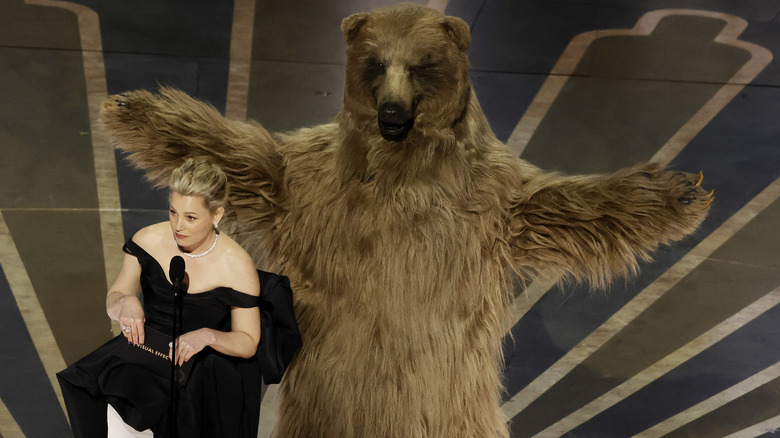How Many People Did Cocaine Bear Kill In Real Life? The Answer May Surprise You
Though it will likely remain drowned out by the once-in-a-lifetime phenomenon that was Barbenheimer, it "bears" repeating that Elizabeth Banks' "Cocaine Bear" was one of the most meme-able movies ahead of its release in early 2023, dominating online spaces with its bombastic trailer and baffling premise. Despite debuting to somewhat mixed-to-positive reviews (with its B-movie mileage apparently varying depending on the view), it can't be said that the film didn't deliver on the most basic premise of its title — that a bear, high on cocaine, would kill a whole bunch of people in the woods. While that may make it a more successful wildlife slasher than, say, this year's "Winnie the Pooh: Blood and Honey," it actually doesn't square with the true story that inspired the script.
The real-life "Cocaine Bear" (affectionately called Pablo Escobear by some) didn't get to go on the indulgent rampage his film counterpart implies he did back in 1985. Though he did indeed tear his way into millions of dollars worth of cocaine unwittingly recovered from a misfortunate drug trafficker, the drugs would only cause the 200-pound black bear to tragically die. Georgia investigators found the bear after it had already died, and a later autopsy would reveal that its stomach was packed with the powdery substance, only three grams of which had actually been absorbed into the animal's system before it would prove fatal.
Yet what the real-life "Cocaine Bear" story lacks in blood, it more than makes up for in strangeness, as Pablo Escobear's posthumous journey is arguably weirder than even the most jaw-dropping of scenes from the Universal Pictures film.
Cocaine Bear is still out there -- and it wants to marry you
What do you do with a bear tragically killed by the litter of man's greed? Why, you stuff it, of course!
After Georgia's then-chief medical examiner Dr. Kenneth Alonso finished his autopsy of the animal, Cocaine Bear was taxidermied and donated to a local wildlife preservation group, though it wasn't under their care for very long. Whether it was stolen or sold, it would vanish sometime after being moved into storage due to wildfire concerns. To be fair, friends don't let friends blaze up after they've tried to snort about 75 pounds of cocaine.
Nevertheless, the creature reportedly wound up in a pawn shop where legendary country singer Waylon Jennings presumably decided, "Yeah, this is exactly how I should spend my 'Dukes of Hazzard' paycheck," and purchased the corpse for an unknown sum. Given the bear's folkish prestige and the general going rate for these sorts of things, it was probably worth upward of $10,000 in today's money. Under Jennings' care, Cocaine Bear made it all the way to Lexington, where it remains in the Kentucky Fun Mall — officiating weddings due to an absolutely incredible legal loophole.
Now, you're probably thinking "Wait, an inanimate object can't marry people, right?" Correct — unless those getting married are under the genuine belief that that object has the legal authority to marry them. This essentially allows the owners of Cocaine Bear to claim that it can, in fact, officiate a legally binding marriage that cannot be overturned by the state of Kentucky in the future. We can all surely agree that the film would've been much better if it ended with a "Cocaine Bear" wedding, but, alas, we can only dream.

